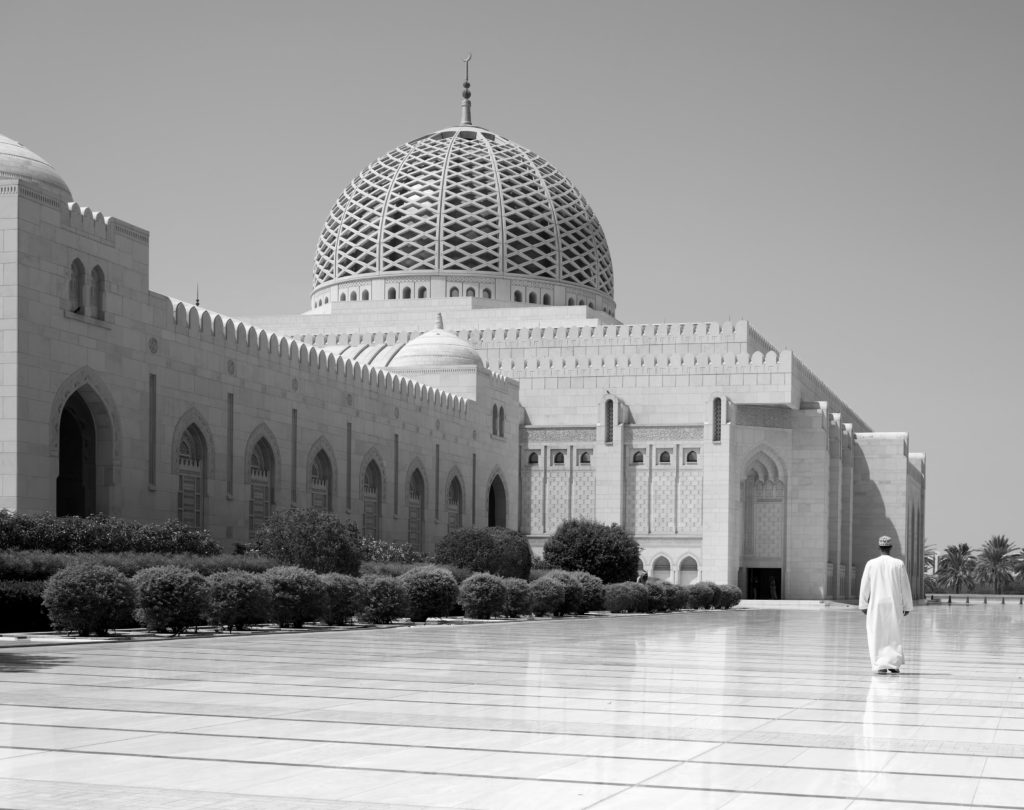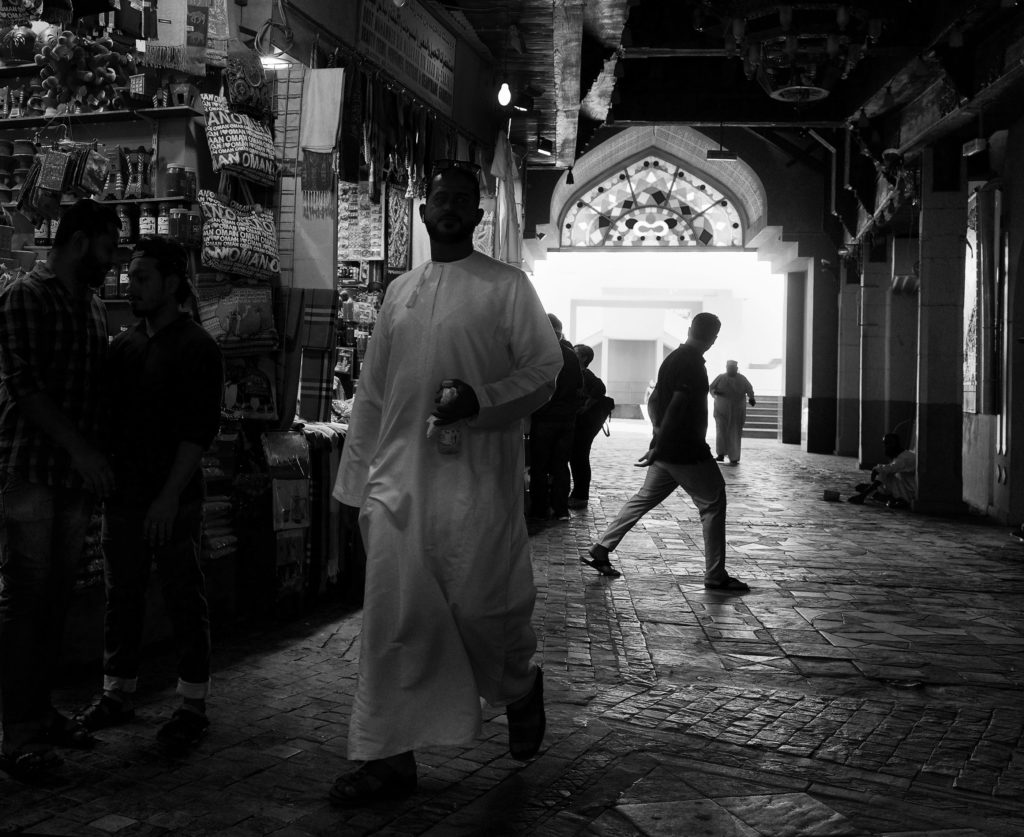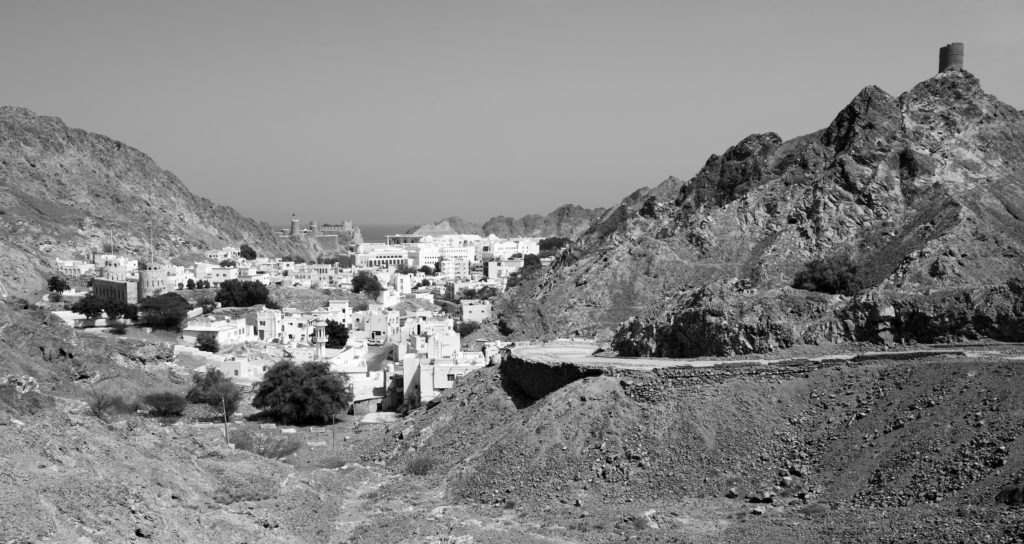The next day we left Muscat and headed for Jebel Akhdar – the Green Mountain. This forms the central section of the Al Hajar (Rocky or Stone) Mountain range, which run for about 700 km thorough Oman and the UAE. They are also known simply as ‘The Oman Mountains’. As their name suggests the range is mostly bare rock and desert. The ‘green’ of the Green Mountain starts at higher altitudes where there is enough rain to support shrubs, trees and agriculture. Damask roses, pomegranates, walnuts and apricots are all grown there.
The peaks of Jebel Akhdar surround a high plateau and have historically created a division between the relatively inaccessible interior and rule from the coast at Muscat. The mountain road is very good though access is relatively recent. As there is a military base on the mountain it was only in 2005 that the mountain was opened up to visitors. There is still a checkpoint at the bottom off the ascent but that is just to ensure that visitors are in possession of a four wheel drive vehicle and a valid driving license.
Birkat al Mouz and Old Birkat
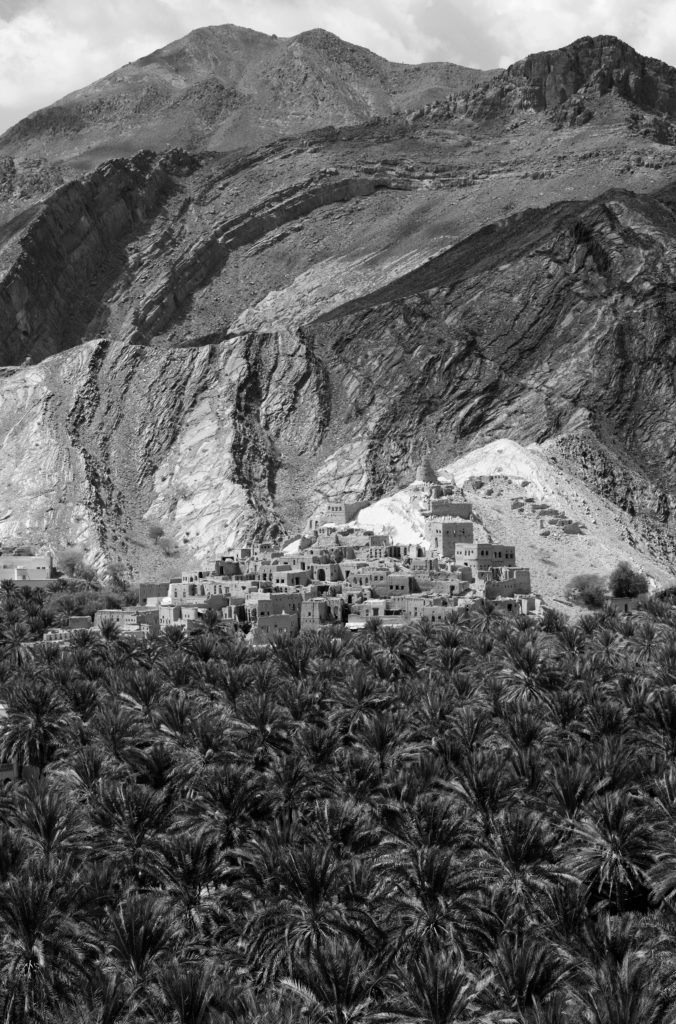
As we neared the mountains we drove up a steep slope to an elevated vantage point. Form there we had a view of the deserted mud brick village of Old Birkat at the base of the mountain. It was a spectacular sight and one I will never forget. I took the shot with the Nikon Z7 and the 24-70mm f4 S kit lens, which I used for all the landscape shots on this trip. I use the smaller and more discrete Leica Q for street photography.
Descending the slope we drove to the nearby town of Birkat al Mouz, which translates to pool of bananas. We drove though a large date plantation and my guide went to pray at a small mosque, leaving me to admire some deserted mud brick houses and the ancient Aflaj irrigation system. In 2006, the Al Sharieh Falaj system, built between 1674-1741, was designated as one of five UNESCO Heritage Sites. Falaj is the singular of Aflaj and this ancient system of water channels dates back some 5,000 years.
The Saiq Plateau and Wadi al Ayn
Continuing our ascent we drove up a series of very steep hairpin bends to the Saiq Plateau – a distance of a little over 30 km. We stopped and walked to the rim of the cliff at Wadi al Ayn, which provided another spectacular, and more panoramic, view. Diana, Princess of Wales, apparently enjoyed the view here on a royal visit to Oman 1986 and there is a viewing point named after her at the nearby Hotel Anatara. It is an incredible vista that takes in a huge gorge with terraced steps cut into the side complete with several villages precariously hanging off the cliffs. For the second time that day I was completely entranced. As we left my guide poured water over a couple of areas of rock to show me some fossils, including an ancient turtle. Finding a marine fossil at such a high altitude was surprising but the rocks of the Hajar Mountains formed under the sea. The Oman mountains, as it turns out, are a geologist’s paradise.
Returning to our Land Cruiser we completed the last of the 50km journey up the Jebel Akhdar to my hotel – The Alila. Here we greeted with typical Omani hospitality of coffee and dates. The Alila is in a spectacular location overlooking another huge gorge. It is built of dark grey local stone and is one of the best examples of modern design I have seen anywhere. It also has an infinity pool that is, for once, not misnamed and a great kitchen. I tried the famous local dish of Suwa and was not disappointed. They also served some delicious Biryani dishes such as Biryani Al Khadruat, B. Samak and B. Dilaj.
My guide had told me that it was market day in the town of Sinaw the following day where the Bedu would be selling their camels and goats. We promptly arranged a day out on that basis.
The Souk at Sinaw
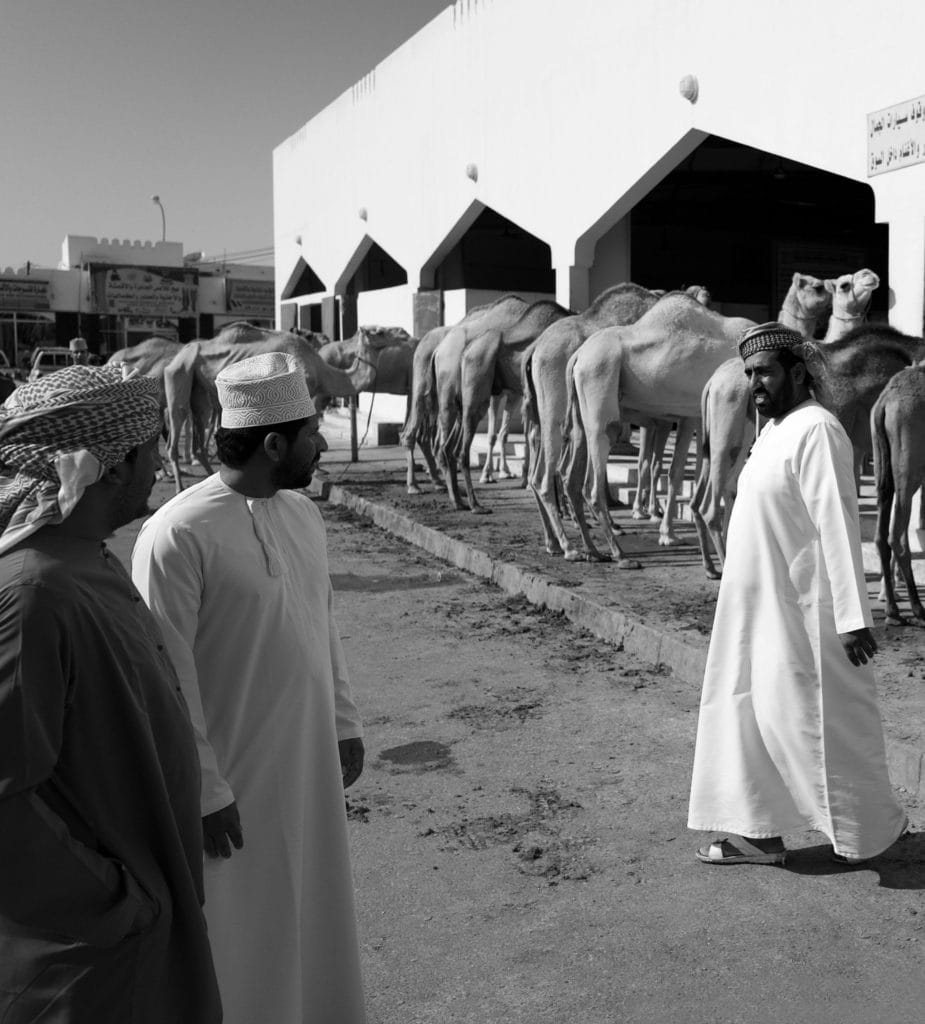
We met at 6.00 AM in the hotel reception and headed down the mountain. Sinaw is in the Al Sharqiya region, not far from the sands of the same name, and about 90 km from the Green Mountain. The town has a large Souk based around an outdoor courtyard and Thursday is market day.
We arrived at about 7.30 having stopped briefly for Qahwa (Omani coffee) and the market was in full swing. There was a continual procession of white Toyota Hiluxes arriving laden with goods and livestock. Tied to posts along one side of the courtyard of the souk were a long line camels, whilst under cover goats were being auctioned, and on the other side there was a substantial fish market. Around the edges vegetables, fresh and dry fruit, dates, dry shark meat, animal feed and much else was for sale. It really felt like a desert town, and only saw one other Westerner whilst I was there.
It was now lunch time and my guide was keen for me to sample camel so we stopped at a place he knew towards the sand. We were served both curried camel and braised camel – I preferred the former which reminder me a little of goat curry.
The Sharqiya Sands
After lunch we headed for the Sharqiya Sands (also known as the Wahiba Sands), stopping at a tyre centre in a nearby town to deflate the tyres to desert running pressures. The sands cover an area 180km North to South and 80km East to West with large longitudinal dunes, that can reach as high as 100m tall. There are no permanent human settlements there, although there are plenty of animal pens at the edge of the desert.
We travelled a few kilometres out into the desert and got stuck in the dunes. My guide was not troubled by this, and after letting a little more air out of the types we escaped and carried on, stopping at a Bedu tent for coffee and dates and a look at various items for sale. Someone had just caught a scorpion and put it in a bottle, which gave me pause for thought. A bit of quick internet research showed that there is an anti-venom available for scorpion stings in Oman, and though the venom typically causes ‘significant local pain and some swelling’, it doesn’t cause the ‘local and systematic toxicity, local tissue destruction and deranged blood clotting’ of local snake bites. I had no idea blood clotting could be deranged and it increased my inclination to avoid Omani snakes.
We hobbled back to the tyre shop using every bit of sand and rough ground we could as the tyres were practically deflated. After a top up my guide enquired if I wanted to head back out to the deep desert, but as we were travelling with a a single vehicle I declined, so I didn’t see the really huge dunes, and need to go back some time.
Wadi Bani Khalid
I had never seen a wadi close up so our next destination was Wadi Bani Khalid, probably the best-known wadi in country, which is also an oasis. The term wadi is a little confusing as it means both valley and riverbed fed by the rains – more of which later. Wadi Bani Khalid is famed for its large green pools which are fed by a constant flow of water though an eroded canyon strewn with boulders.
Perhaps because it is such a short walk from the car park to the pools, the wadi has been developed for tourism and has bridge and seating areas, where you can sit and watch the teeming fish. It is very popular with picnickers, but it was very quiet when we were there. There is a cave network near the pools but we decided not to go in. The sky above had become heavy with rain clouds and dangerous flash floods can develop quickly.
After that it was time to head home. It’s around 250 km drive from Wadi Bani Khalid to the Alila on Jabal Akhdar so we got back about 7 PM.
Nizwa – the Old Mountain Capital
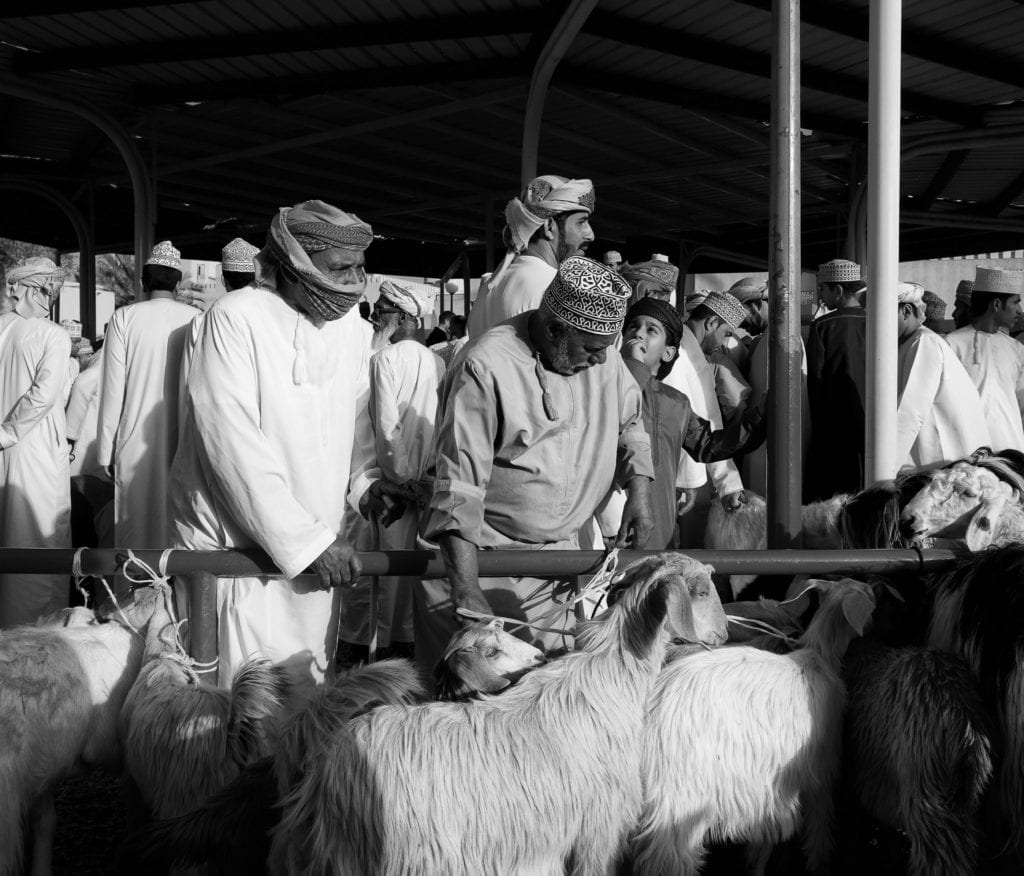
The next day I was up even earlier, and met my guide at 5 AM in the hotel reception. Nizwa is a short drive away, but the action at the famed livestock market there is best seen early.
Nizwa is an ancient place located in the heart of the country at the base of the Oman mountains. It was the nation’s capital in the 6th and 7th century, and was an early to convert to Islam. Traditionally conservative, it was another destination that thwarted explorer Wilfred Thesiger during his time in Oman. His account of his time in the Arabian Peninuslar Arabian Sands is well worth reading and provides a glimpse into a vanished nomadic lifestyle.
As soon as we arrived, we headed straight for the market. It was heaving with activity and the auctioneers where busy leading sometimes reluctant goats round in a large circle for buyers to inspect. I stood on the outside and then made my way into the centre where I could shoot down on the action, capturing the image shown here.
Nizwa is known for its imposing fort built in 1668. It is one of Oman’s most-visited national monuments and was our next visit. It also has a good souk where you can find handcrafted silver Khanjars along with many other forms of silver craftsmanship. It is also known for pottery, goat wool textiles and high quality dates. Around the back of the market were some tables where Khanjars and old Lee Enfield rifles were for sale. That might sound edgy, but it really wasn’t at all – Nizwa is a major tourist destination and I felt perfectly safe all the time I was there.
We had a most delicious lunch of grilled lamb and a flatbread wrap of salad from a packed little kebab shop and then headed back up the mountain to the Alila, where I spent my final day in the Oman mountains admiring the astonishing view from in and around the hotel pool. It had been a fantastic trip and I would love to go back, the people, the culture and landscape make it one of the most interesting countries I have ever visited.
The Unexpected Wadi
My visit to the Oman mountains were a great adventure – even my return to the UK was a little more exciting than I had expected as it started to rain hard just as I was about to leave for the airport. The hotel told me to expect to spend another night as the mountain road is closed at the checkpoint when it rains, but it was only raining at the top of the mountain and my driver lived close so he arrived as scheduled.
It was an interesting journey down the mountain as the rain had dislodged a lot of shingle and small boulders and we can encountered quite a bit of flooding. Shortly into our descent, the driver told me we might have to wait for a little while ‘at the wadi’. We soon came across a raging torrent in our path. I eyed the fast moving water pensively. “That doesn’t look very much like the last wadi I saw” I said. My driver waved his hand in a dismissive gesture and told me that he lived on the mountain, that this was nothing out of the ordinary and we would cross without difficulty. I believed him on the first two points… Happily he was right on all points and we were soon through the flood water. The rain stopped as we got to a lower altitude and before long I was bidding farewell, but I hope not goodbye, to Oman at Muscat airport.
